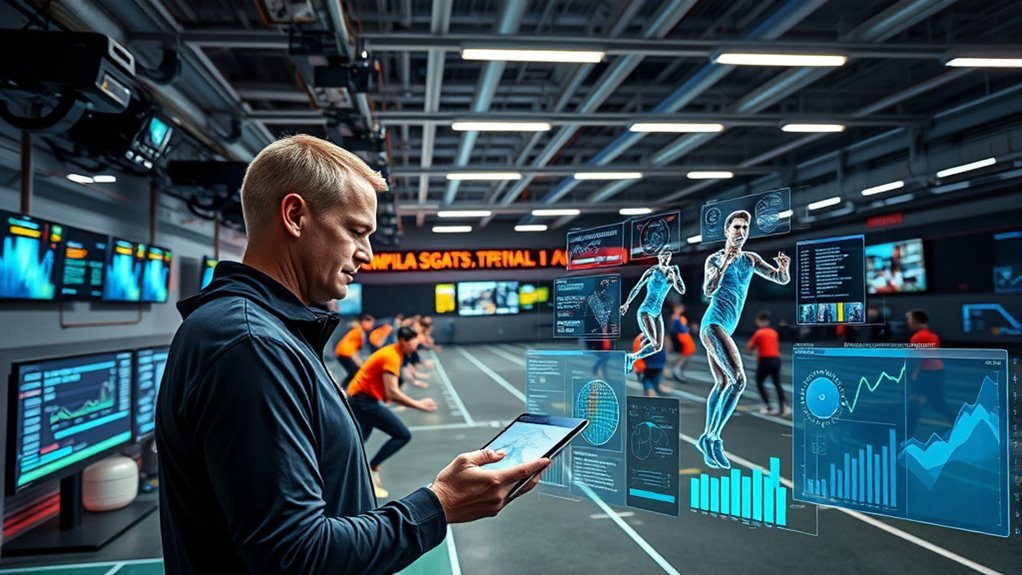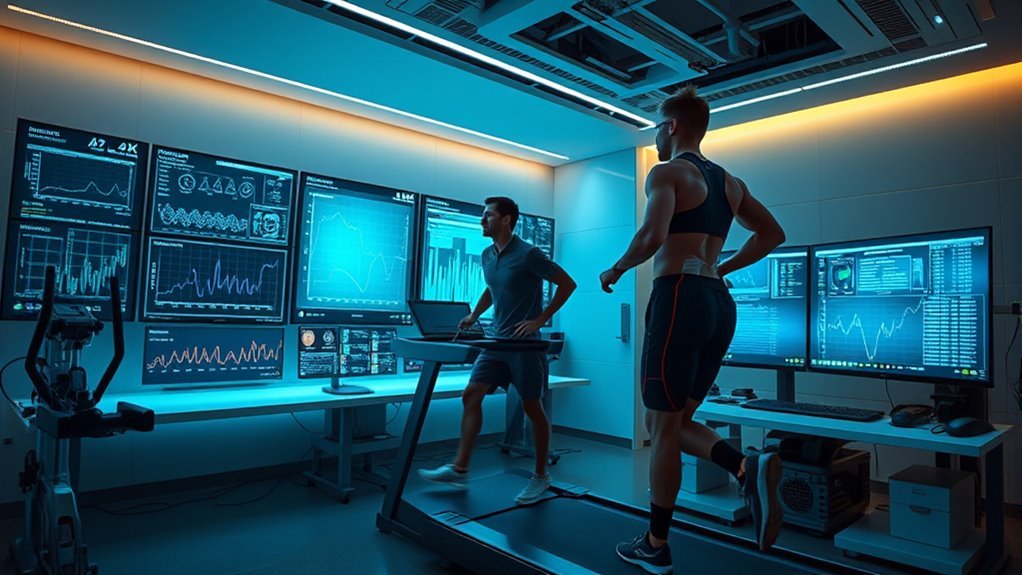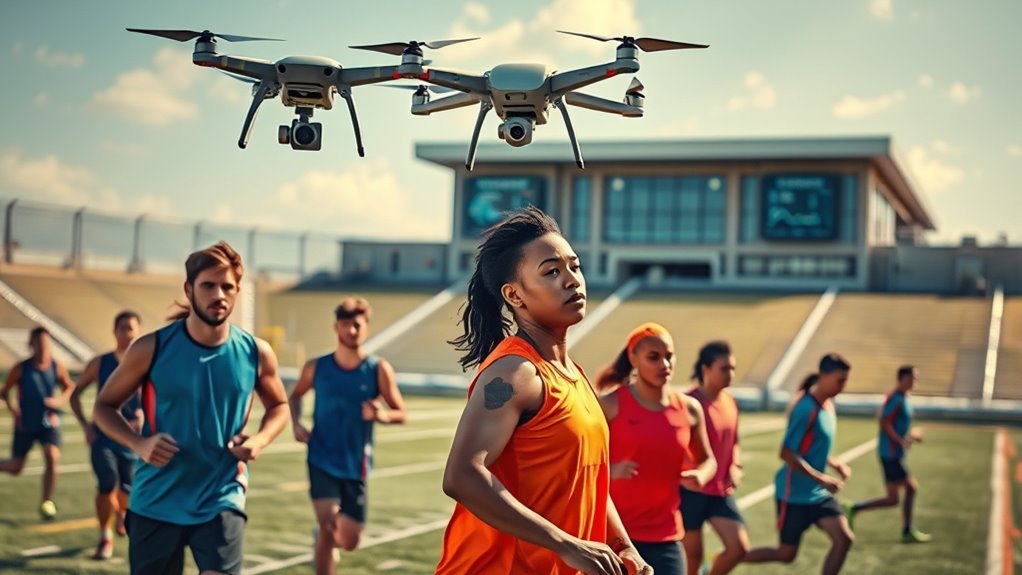When developing AI for sports analytics and performance tracking, you leverage computer vision and wearable tech to gather real-time biometric and positional data. Integrating diverse sensor inputs creates a unified, accurate dataset for machine learning models that predict player performance and injury risks. Real-time analytics then enable immediate tactical decisions based on objective metrics rather than intuition. While this approach boosts precision and strategic insights, addressing challenges like data quality and model transparency remains essential. Exploring these aspects reveals deeper opportunities and complexities.
Key Technologies Driving AI in Sports

While AI’s impact on sports is broad, its effectiveness hinges on several key technologies that process and analyze vast amounts of data in real time. You’ll find computer vision central to this effort, enabling automated tracking of player movements, ball trajectories, and game events with high accuracy. This continuous visual data feeds AI algorithms that deliver actionable insights instantly. Complementing this is wearable technology, which captures biometric and physiological metrics such as heart rate, acceleration, and fatigue levels. By integrating these data streams, AI models can assess performance metrics and injury risks with precision, empowering you to make informed decisions freely without relying on subjective observation. Together, computer vision and wearable tech form the backbone of AI-driven sports analytics, transforming raw data into real-time intelligence that enhances performance and strategic planning. Leveraging on-demand access to computing resources ensures these AI models can process data efficiently and scale as needed.
Data Sources and Integration Techniques

Data in sports analytics comes from diverse sources, each offering unique insights that, when integrated effectively, provide a thorough understanding of performance and strategy. You’ll encounter data collection from sensors, GPS trackers, video feeds, and biometric monitors, each capturing specific performance metrics. To harness this data’s full potential, you need robust integration platforms that unify heterogeneous datasets into a cohesive framework. These platforms enable seamless synchronization, normalization, and real-time processing, allowing you to access extensive, multi-dimensional views of athletes and game dynamics. By leveraging precise integration techniques, you reduce data silos and improve analytics accuracy. This approach empowers you to make data-driven decisions without sacrificing flexibility, giving you the freedom to explore innovative performance optimization strategies grounded in a well-integrated, reliable data ecosystem.
Machine Learning Models for Performance Prediction

Integrating diverse datasets lays the groundwork for applying machine learning models that predict athletic performance with greater accuracy. By leveraging historical player performance and biometric data, you can build predictive modeling systems that identify patterns conventional analysis might miss. Choosing the right algorithm depends on your specific goals and data structure.
| Model Type | Strengths |
|---|---|
| Regression | Quantifies continuous outcomes |
| Decision Trees | Handles nonlinear relationships |
| Neural Networks | Captures complex patterns |
| Support Vectors | Effective with high-dimensional data |
Each model offers unique insights, enabling you to forecast performance trends and injury risks. A data-driven approach empowers you to optimize training and strategy, freeing you from guesswork while enhancing precision in evaluating player potential. The integration of predictive behavior analysis in these models further enhances the ability to anticipate user actions and improve outcomes.
Real-Time Analytics and Decision Making
As you monitor live game events, real-time analytics provide immediate insights that can transform decision-making on the field. By processing data from sensors and video feeds, these systems deliver instant feedback on player positioning, fatigue levels, and tactical effectiveness. You gain the freedom to adjust strategies dynamically, optimizing live performance based on objective metrics rather than intuition alone. This data-driven approach enables precise substitutions, formation changes, and targeted coaching interventions, all within critical game moments. The ability to analyze patterns as they unfold empowers you to exploit opponents’ weaknesses promptly. Real-time analytics consequently bridges the gap between raw data and actionable decisions, enhancing competitive edge while maintaining agility. Embracing this technology means leveraging continuous feedback loops that elevate performance without compromising your strategic autonomy. Implementing such systems often benefits from prompt chaining techniques to ensure iterative refinement and deeper insights in decision-making processes.
Challenges and Future Trends in Sports AI
While AI has revolutionized sports analytics, you’ll face significant challenges in data quality, model interpretability, and real-time integration. Ensuring the accuracy and completeness of diverse datasets is critical, as biased or incomplete data can skew performance insights. You’ll also need to balance model complexity with transparency, making decisions understandable to coaches and athletes. Ethical considerations come into play, especially regarding athlete privacy and data ownership. Privacy concerns intensify as wearable sensors and video analysis collect sensitive information continuously. Looking ahead, you can expect advances in federated learning and explainable AI to address these issues, enabling decentralized data processing and clearer decision rationale. Embracing these trends will grant you greater freedom to innovate while respecting ethical boundaries in sports AI development. Prioritizing ethical principles in AI design ensures that innovations protect individual freedoms and foster trust among all stakeholders.



